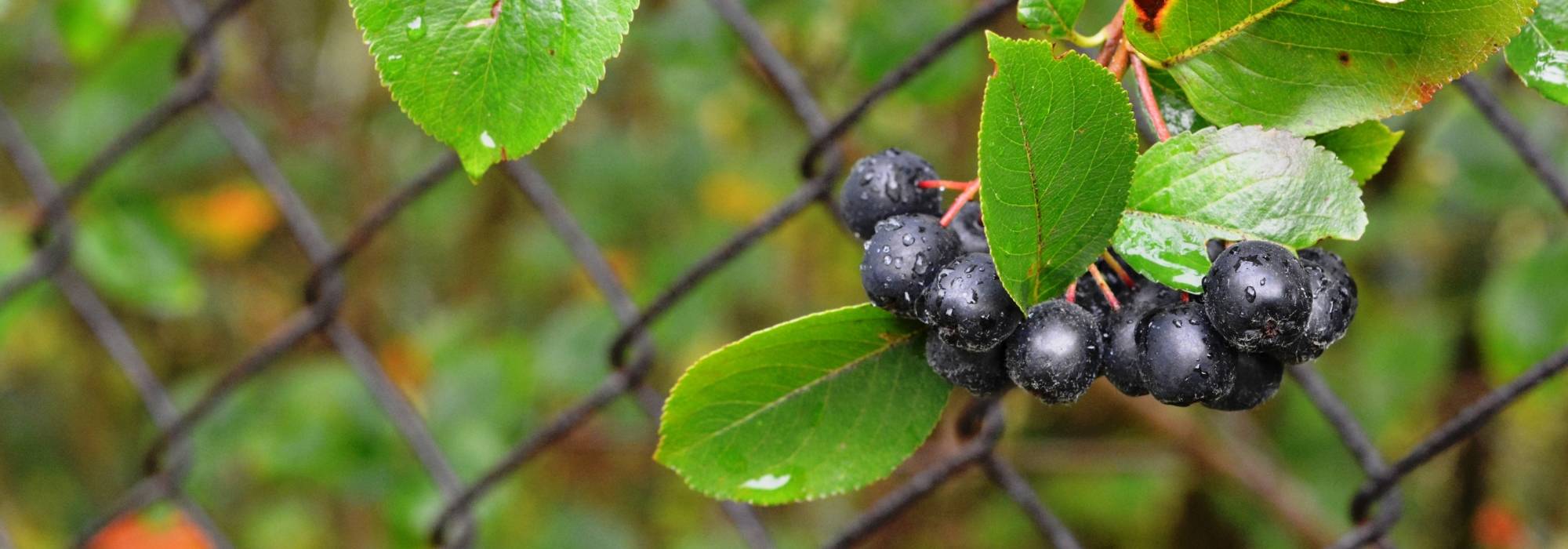
Aronia: planting, pruning and care
Contents
Aronia in a nutshell
- Aronia is a very hardy North American bush, growing between 1.5 and 3 m tall, suitable for hedges, borders, or orchards.
- Its deciduous, single, dark green leaves turn stunning shades of orange-red to purple in autumn.
- Its appeal also lies in the black or red berries, which are much richer in antioxidants than most fruits and are recommended for health.
- It is not demanding regarding soil type as long as it is not too rich in lime, but it prefers full sun.
A word from our expert
The Aronia, this small-fruited bush of North American origin, attracted significant interest in Eastern Europe, Russia, and Scandinavia in the early 20th century for its hardiness and production of health-beneficial berries. Numerous cultivars were produced by the Russian hybridiser Ivan Michurine in the 1950s, contributing to its spread. Native Americans used the berries, which resemble blueberries, for medicinal purposes. The antioxidant power of dried berries from Aronia melanocarpa or purple aronia (Aronia x prunifolia), four times greater than that of fresh berries, far surpasses that of other small fruits like raspberries or blackberries.
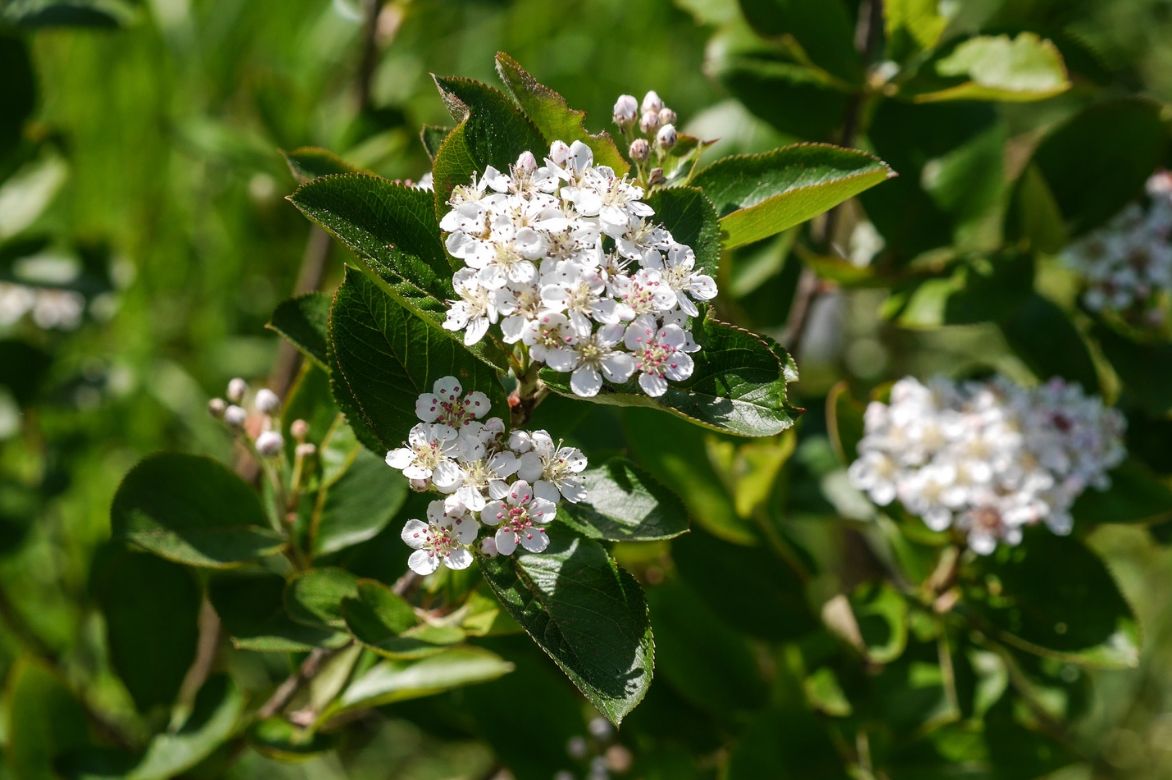
Aronia flowers (photo Dieter Heinrich-Flickr)
This understorey bush, reaching heights between 1.5 m and 3 m, offers a generous display of white flowers in spring while providing a feast for birds during the colder months. It is also an excellent ornamental bush, showcasing beautiful autumn colours, particularly splendid in the Aronia arbutifolia Brilliant, adorned with bright red foliage in October. Hardy, robust, and low-maintenance regarding soil as long as it remains moist, aronias are more floriferous and colourful in autumn when exposed to sunlight. These slightly suckering plants thrive in free and wild hedges or in borders, where they are truly spectacular when planted in groups of 3 to 6 of the same variety.
The aronia with strawberry tree leaves (Aronia arbutifolia), which produces red berries, has escaped gardens and increasingly occupies French territory since the 1980s-90s, to the point of being considered invasive in Gironde in particular. It colonises heathland, understorey, and recently opened pine forests due to seed dispersal, thriving in dry to moist soils, especially if acidic.
Description and Botany
Botanical data
- Latin name Aronia sp.
- Family Rosaceae
- Common name chockeberry
- Flowering between April and June
- Height between 1 and 4 m
- Sun exposure sun, partial shade or shade
- Soil type any soil even poor, without excess lime
- Hardiness Excellent (-28°C)
The Aronia or Aronia is part of the Rosaceae family, like bramble or blackthorn. The genus consists of only two species, melanocarpa and arbutifolia, both native to the same region in eastern North America and capable of naturally hybridising. The taxa Aronia X prunifolia (Purple Aronia) and Aronia X florinbunda are among these natural hybrids. They occupy thickets, wet slopes, and open woodlands.
These deciduous bushes, with rapid growth, form spreading clumps, reaching 2-3 m high in arbutifolia, while being dense, low, and compact in melanocarpa. As their Latin names suggest, the former has dentate lanceolate leaves resembling those of the strawberry tree (Arbutus), while the latter is distinguished by its clusters of black berries at ripeness, from the Greek melanos meaning “black” and karpos meaning “fruit”. The genus name Aronia comes from the Greek aria, a name given to the service tree or medlar. The shallow rooting consists of fine fibrous roots that easily establish in the litter layer of a forest.
The leaves are alternate, simple, ovate, and finely dentate, measuring 4 to 8 cm long, with a relatively short petiole. The leaves of the black-fruited aronia are a darker green than those of the strawberry tree-leaved aronia. The foliage takes on magnificent fiery red hues, sometimes slightly purplish, which truly brighten up the dreary autumn days.
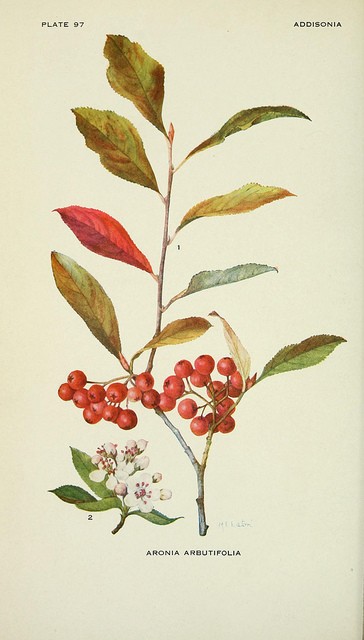
Aronia arbutifolia – botanical illustration
The white or pink flowering of these bushes occurs in May-June, forming corymbs of 10 to 25 small flowers with 5 petals. The corolla measures about 1 cm in diameter, sometimes more in varieties like melanocarpa ‘Autumn Magic’. The large cluster of stamens and the light fragrance of the flowers attract numerous pollinators that ensure very good pollination close to 90% during dry periods.
The small green berries turn red in arbutifolia and then black in melanocarpa. Their size resembles that of a blueberry, sometimes reaching 1.5 cm in fruiting selections. They are botanically drupes as the fruit contains a stone. They are both decorative due to their abundance and edible, especially in cultivars Aronia x prunifolia ‘Viking’ or ‘Nero’ resulting from the cross-breeding of the two species. Aronia arbutifolia ‘Brilliant’ is the most marketed bush among enthusiasts due to the shine and vibrant colour of its leaves in autumn, although its berries are less tasty. Despite their slightly sour and astringent pulp, birds relish them, helping to disperse the seeds. Their English name chokeberry suggests that birds tend to choke from overindulgence.
The fruits take almost 3 months to ripen. It is important to harvest them before the corymb disintegrates. Beware of the fruits as they are very staining! Production begins on plants aged 3-4 years from sowing and reaches its maximum after 7 years. Yields can reach 2.4 kg per plant. You can keep them for up to 2 weeks in the refrigerator or freeze them, dry them (their antioxidant power is then four times higher!), or cook them in pies… It is advisable to add sugar or mix apple, grape, or cranberry juice with aronia juice to sweeten it.
The cooking of the berries harvested from September to December develops a powerful blackcurrant flavour, appreciated for accompanying meats, colouring sauces, or in jams. Aronia juice serves as a colouring agent for syrups, wines, and confectionery. However, the notoriety of this fruit mainly comes from its medicinal properties due to the presence of antioxidants (flavonoids, anthocyanins…) as well as vitamins C, B1, B2, provitamin A, and fibres… Its consumption helps combat cardiovascular diseases, macular degeneration, protects the skin against the effects of the sun, lowers blood sugar levels in diabetics, in short, slows down the ageing of cells.

Aronia: evolution of flowers into fruits
“`
The main varieties of Aronia
Selected Varieties for Fruits
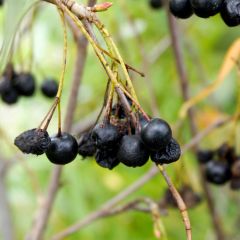
Aronia melanocarpa Autumn Magic
- Flowering time May, June
- Height at maturity 1,50 m
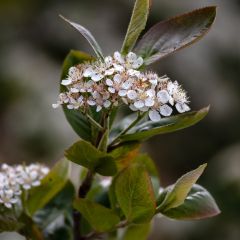
Aronia prunifolia Viking
- Flowering time May, June
- Height at maturity 1,50 m
Selected Varieties for Autumn Foliage
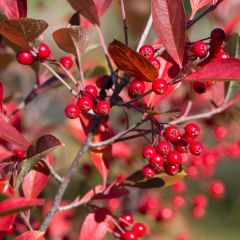
Aronia arbutifolia Brilliant
- Flowering time May, June
- Height at maturity 3 m
Discover other Aronia
View all →Available in 2 sizes
Available in 2 sizes
Available in 2 sizes
Available in 1 sizes
Available in 1 sizes
Available in 1 sizes
Available in 1 sizes
Available in 1 sizes
Available in 1 sizes
Available in 2 sizes
Planting
Where to plant Aronia?
Naturally very resistant to diseases and pests, Aronia is an excellent bush for free hedges, being both hardy, ornamental, and low-maintenance. While it tolerates the presence of lime and adapts to poor soils, it will only reach its full potential in fresh, deep, slightly acidic soil.
Plant it in a sunny position that is never scorching, or partially shaded, around a vegetable garden or within a clearing. In shade and lime-rich soil, the colours are more muted. The hardiness of this Canadian bush is excellent, even in wet soil, reaching -28 to -35°C.
Its late flowering is not afraid of frost and attracts many beneficial insects that will help maintain biodiversity in the garden.
When to plant?
Aronia is best planted in early spring or early autumn in any good garden soil.
How to plant?
- Soak the root ball in a bucket of water to thoroughly moisten it.
- Dig a wide planting hole, at least 50 cm wide to encourage suckering. Space the plants 1 m apart in the row and 3-4 m between rows if you are planting an orchard.
- Add decomposed compost or potting soil to lighten and enrich the soil, possibly heather soil if your soil is lime-rich.
- Place the plant in the planting hole.
- Backfill the hole and lightly firm the soil.
- Water generously.
- Spread a layer of mulch at the base to maintain good moisture around the roots. This will also limit the growth of weeds.
Establishment is easy and quick, requiring only monitoring of watering during the first 2 years following planting.
Transplanting is well tolerated due to shallow rooting.
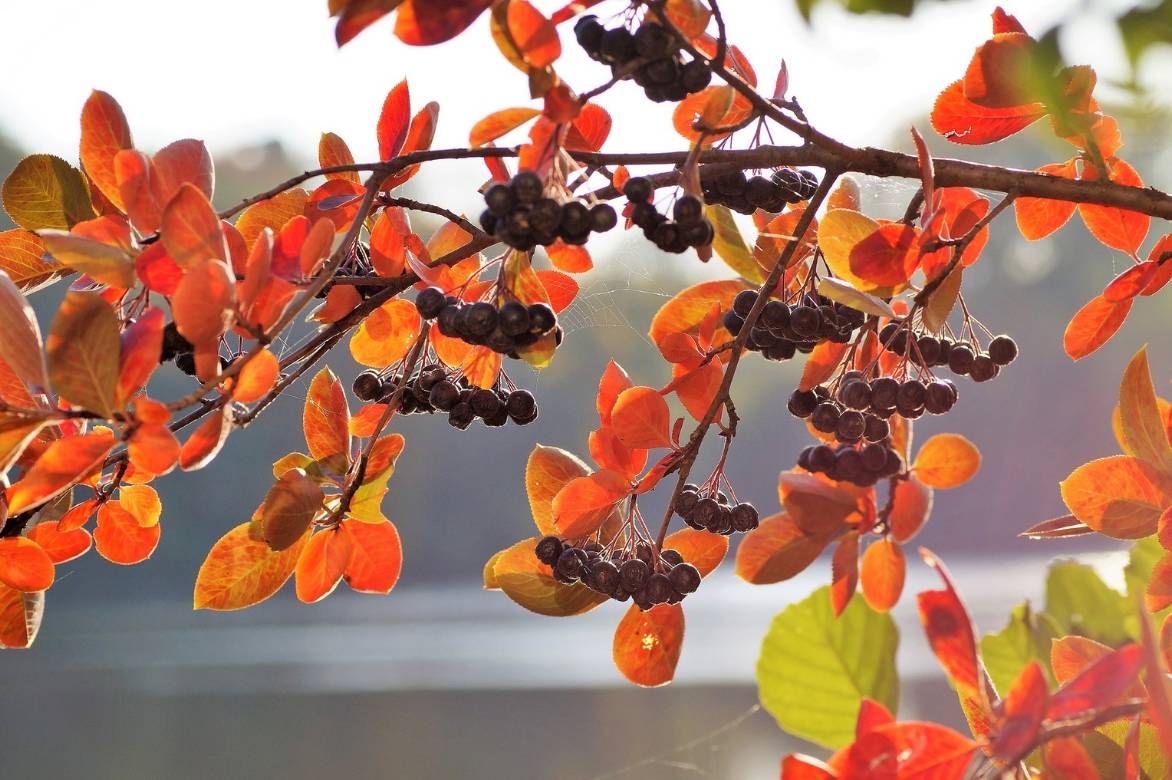
Superb autumn colouring of Aronia argutifolia
Read also
How to plant a hedge?Pruning and care
Maintain soil moisture through regular watering to enhance growth and fruit harvest during prolonged dry spells. Don’t hesitate to mulch and apply compost in autumn or fertiliser for fruit trees if the bush is growing in a container or large pot. Protect the bush with a filament at the end of summer to deter birds. Production becomes significant after 3-4 years.
Prune the shoots to half their length at the end of winter, between February and April. Remove dead or weak wood and one-third of the old stems at the base in rotation to renew the shoots.
Aronia is naturally highly resistant to diseases and parasitic threats. Learn more in Diseases and Pests of Aronia.
→ Learn more in our tutorial: How to Prune Aronia?
Multiplication: propagation by cuttings, sowing
It is easy to divide suckers in winter, propagate by cuttings, or sow Aronia.
Propagation by Cuttings
Operate in June on softwood or in September-October on hardwood.
Prepare a pot deep by filling it with potting soil mixed with sand, or carry out your cuttings in the open ground if it is light, after aerating it with a fork, then moistening it.
- Take a lignified branch 10 cm long from a shoot of the year.
- Remove the leaves near the base of the cutting, and trim the others to reduce the leaf area.
- Insert the cuttings two-thirds of their height, ensuring they do not touch each other.
- Gently firm the soil around to eliminate air pockets and ensure good contact between the potting soil and the cutting.
- Place the June cuttings in a humid environment in the shade, for example, by covering them with a cut transparent plastic bottle. The autumn cuttings are done in the open air.
- By the end of September, remove the bottle and place the culture under a frame until spring.
- Separate the rooted cuttings in spring to plant them in individual pots until the following autumn.
Sowing
- Harvest the fruits in autumn and remove their pulp.
- Store the stones in a cool place.
- Sow the seeds in spring.
- Push the seeds 1 cm deep into a light substrate that you keep moist. Germination occurs after 2 to 3 months.
Uses and associations
Aronia can be used in isolation, free hedges, countryside hedges, or groups, but for a more spectacular effect, plant it in groups of 3 to 6 young plants of the same variety. It is equally suitable around a vegetable garden among a fruit hedge composed of blueberries, blackcurrants, raspberries, and gooseberries. However, Aronia can also create a beautiful and fruitful hedge with other shrubs featuring foliage or flowers, such as ornamental apple trees, plum trees, and cherry trees, deciduous viburnums, honeysuckle (with decorative but inedible fruits!), witch hazels, Japanese Goumi (Elaeagnus multiflora), sweetshrub (Calycanthus floridus), honeyberry (Lonicera kamtschatica with edible blue fruits), sea buckthorn (Hippophae rhamnoides with edible orange fruits), Goji (Lycium barbarum), and blueberries.
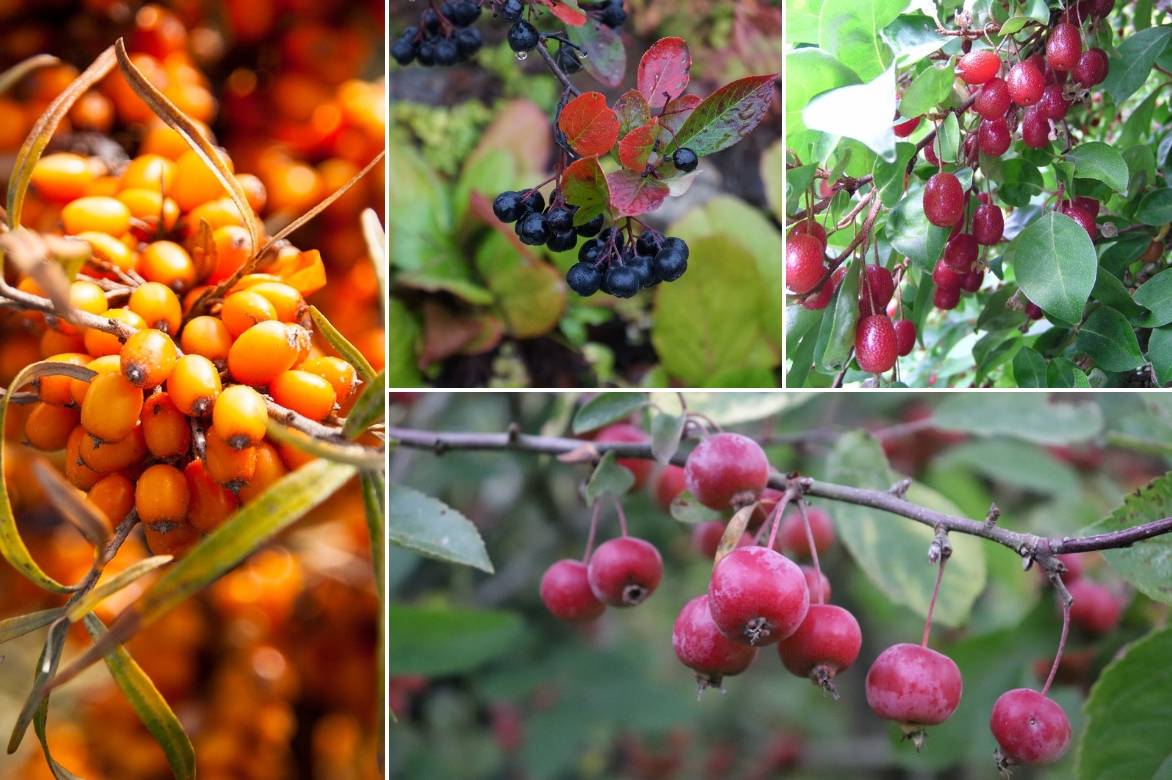
An example of a combination for a fruitful hedge: Hippophae rhamnoides, Aronia arbutifolia, Elaeagnus multiflora, and Malus ‘Evereste’
Choose the variety of Aronia based on its vigour and the desired objective. Although all Aronia fruits are edible, those of Aronia arbutifolia, which boasts spectacular autumn colours, are less tasty. Among the new cultivars, Aronia melanocarpa Autumn Magic offers a good compromise. It is a beautiful improvement over the black-fruited Aronia, combining the qualities of Aronia arbutifolia ‘Brilliant’ and those of Aronia melanocarpa. More compact (1.5 m), bushier, and more brilliantly coloured in autumn, this variety offers a lovely spring flowering that will produce shiny black, edible fruits with a flavour superior to that of the wild species. It is at the end of the season that this Aronia, dressed for the occasion, will be most appreciated, adorned with orange to reddish-purple foliage and generous clusters of black with red peduncles that will make a statement even in a pot garden or on a terrace. Its relatively slow growth gives it a dense foliage and smaller leaves than the type, in glossy dark green tones that truly blaze in autumn. The beauty of its smooth reddish-brown bark is complemented by a profusion of large (2 cm) white flowers speckled with pale pink, highly fragrant and melliferous in April-May.
Did you know?
Recently, there has been a hybrid resulting from the cross-breeding between Aronia melanocarpa and the rowan (Sorbus aucuparia), which forms a small tree of 3 to 5 m with compound foliage, splendid in autumn, and whose flowering resembles that of the rowan: Sorbanoria mitchurinii.
To go further
Discover our range of Aronia.
Find out how to dry Aronia berries in our tutorial.
The opinion of the National Botanical Conservatory of the South Atlantic on invasive species.
Discover how to make homemade Aronia jam and how to make an infusion of Aronia berries? in Gwenaëlle’s tutorials.
Our advice sheet: Choosing an Aronia.
- Subscribe!
- Contents
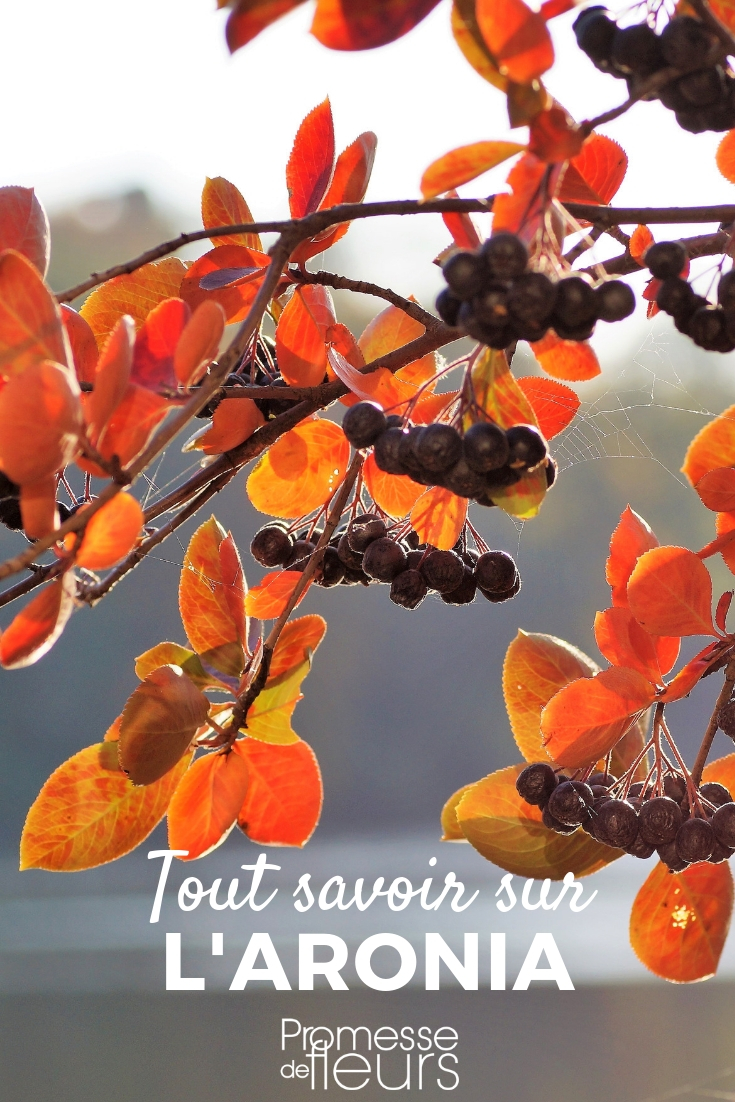
































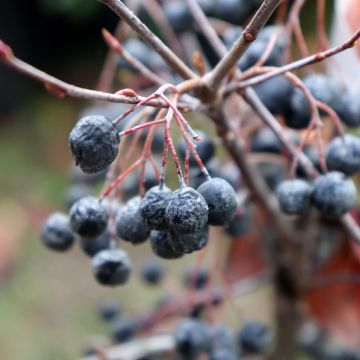

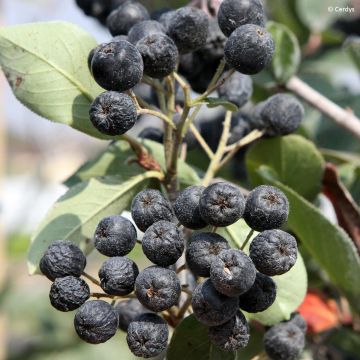
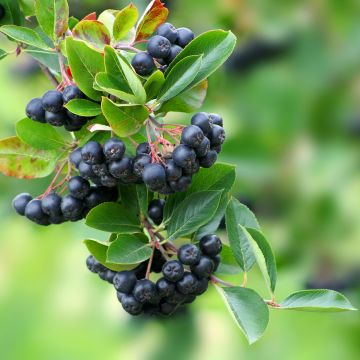
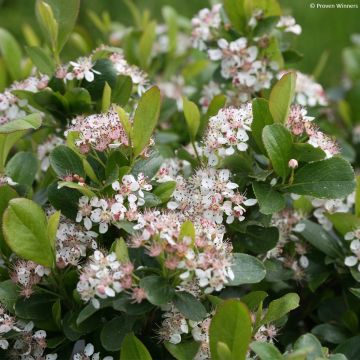
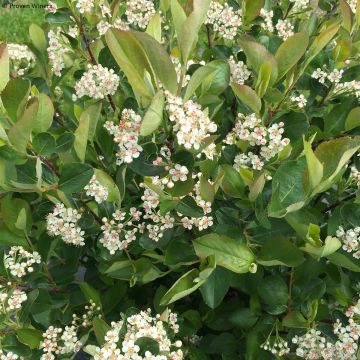
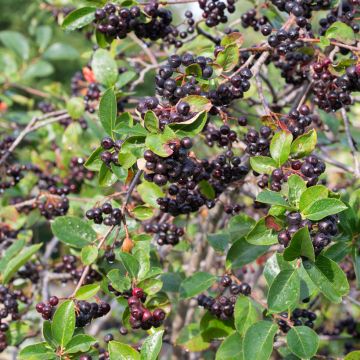
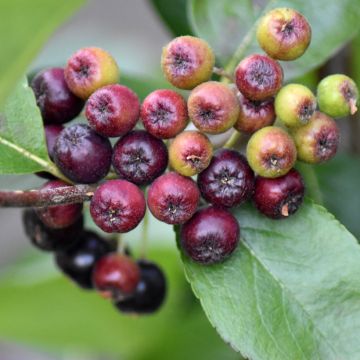

Comments